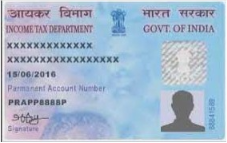POLITY AND GOVERNANCE
PAN CARD
The Indian Tax Department issues a 10-character identifier for any "person" who applies or the department that assigns a number without request. The Indian Revenue Department, under the direction of the Central Direct Tax Board (CBDT), also serves as an important diagnostic tool. The PAN Card is not accepted as proof of Indian citizenship because it is also issued to foreign nationals (such as investors) with a valid visa. PAN is required to file income tax.
INTERPRETING PAN:
The structure of the PAN is as follows: [p - Individual or
Individual] the fourth character. AAAPZ1234C is an example.
The first five letters (in the capital) are letters. The next four letters are digits, while the tenth letter is a letter. The first three letters of the code are three letters containing the sequence of letters from AAA to ZZZ. The fourth character describes the type of card carrier
The letter from the alphabetical list below identifies each type of owner: H HUF [Unified Hindu family / undivided Hindu family]; L Local Council; A: Artificial legal person; C: Company; F: Strong; G: Government; H HUF [united Hindu family / non-divided Hindu family]; L Local Council; A: A transitional legal person P: Individual or individual Character T stands for Trust (AOP). The fifth letter of one of these: personal surname or surname in the case of a personal "PAN" card, where the fourth letter is "p", or the company. The tenth letter is the alphabetical number that acts as a checksum to ensure that the value of t is correct.
THE AADHAAR NUMBER
AADHAAR is a unique identifier with 12 numbers that Indians
can obtain based on biometric and human information. The AADHAAR registration
process involves the use of basic human data paired with ten fingers, both
iris, and a photo to identify the individual separately through the repetition
process.
E-AADHAAR
E-AADHAAR is a
digitally protected copy of the AADHAAR digit signed by the relevant UIDAI
Authority.
FEATURES OF AADHAAR
AADHAAR one: a unique number, which cannot be repeated
because it is connected to their biometrics; it helps to identify false and
ghostly identities. Savings on double use and AADHAAR-based fraud will enable
governments to help eligible citizens. Carrying and authentication: AADHAAR is
a universal number, and agencies and services can contact unique diagnostic
data from anywhere in the country to ensure they are eligible to benefit from
access to authentication services. The inclusion of poor and oppressed
residents without IDs available for Government benefits. Electronic benefits transfer:
The UID-Enabled-Bank-Account network will provide a secure and affordable
platform to deliver benefits directly to residents without the hefty costs
associated with today’s distribution of benefits.
AADHAAR-based certification to ensure the right granted to
the beneficiary: UIDAI will provide online verification services to agencies
wishing to verify ownership of the residence; this service will enable access
to the intended recipient. Improved performance with obvious increase; Open
accountability and transparent monitoring will greatly improve the availability
and quality of beneficiary and agency rights as well.
Self-care puts
residents in control: Using AADHAAR as a guarantee, citizens should be able to
access up-to-date information on their rights, seek services and resolve their
complaints directly from their cell phones, stores, or other means. In the case
of a resident's cell phone, security is guaranteed to be used to verify the
authenticity of two items (eg by verifying the availability of a registered
cell phone number and AADHAAR PIN details). These rates are in line with the
rates and approved payments of the central bank of India.
YOU NEED THE KNOWLEDGE TO GET AADHAAR
The AADHAAR (Enrollment and Update) Regulations, 2016 provide
the personal and biometric details required during the AADHAAR registration
process based on the information provided below: Personal information required
- name, date of birth, gender, address, parent/guardian details (required for
children), Phone details and email details (if required) Biometric details are
required - photo, 10 fingerprints, Iris.
VIRTUAL ID (VID)
VID is a 16-digit
temporary number that can be paused with the AADHAARA map number whenever
authentication or e-KYC services are created. Authentication can be done using
a VID in the same way as using an AADHAAR number. Cannot retrieve the AADHAAR
number from VID.
BENEFITS OF AADHAAR
AADHAAR means foundation, so it is the foundation on which
any delivery system can be built. AADHAAR can be used for any program that
requires the acquisition of residential ownership and/or to provide secure
residents' access to the services/benefits offered by the system. AADHAAR can
be used for the delivery of the following programs: Community Delivery Program,
Food Security, Lunch, Integrated Child Development Scheme. Employment - Mahatma
Gandhi National Rural Employment Guarantee Scheme, Swarna Jayanti Gram Swarozgar
Yojana, Indira Ahwaz yojana Program Assurance Assurance Program. Education-Seva
Shiksha Abhiyaan, the right to education (Children between the ages of six and
14 under Sarva Shiksha Abhiyan, similarly, will not require compulsory
registration of AADHAAR). Inclusion and Social Security - Janani Suraksha
Yojana, Older Persons' First Aid Development Pension Scheme. Aam Aadmi Bima
Yojana. Other integrated purposes include Property Transaction Voter ID, PAN
Card, etc.





Comments
Post a Comment